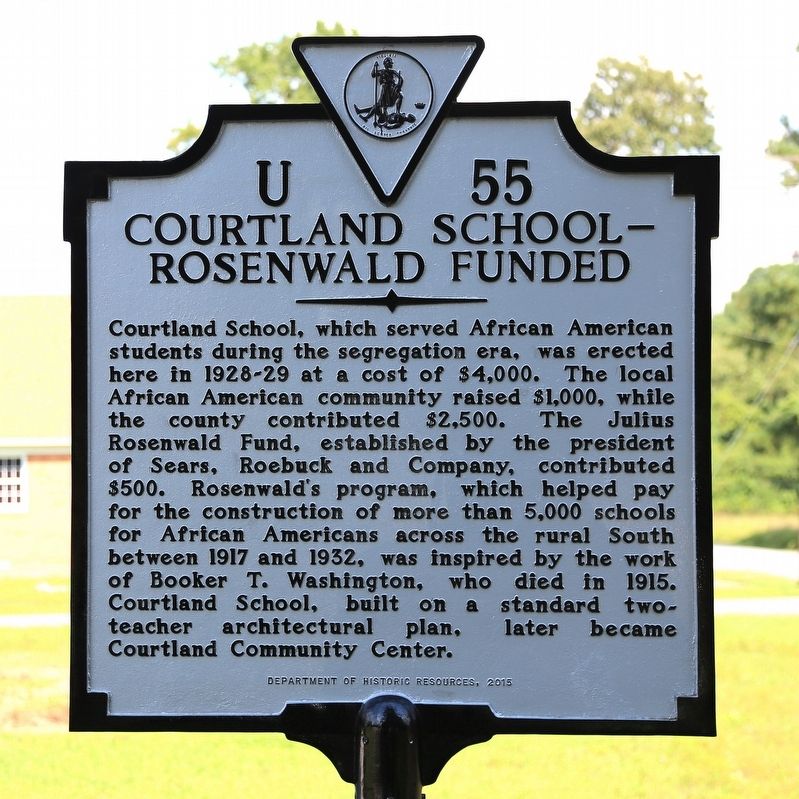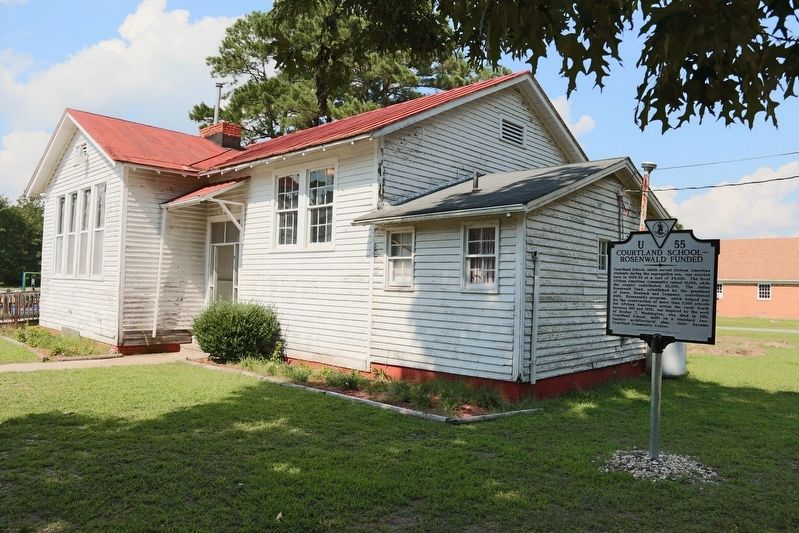Courtland in Southampton County, Virginia — The American South (Mid-Atlantic)
Courtland School — Rosenwald Funded
Courtland School, which served African American students during the segregation era, was erected here in 1928-29 at a cost of $4,000. The local African American community raised $1,000, while the county contributed $2,500. The Julius Rosenwald Fund, established by the president of Sears, Roebuck and Company, contributed $500. Rosenwald’s program, which helped pay for the construction of more than 5,000 schools for African Americans across the rural South between 1917 and 1932, was inspired by the work of Booker T. Washington, who died in 1915. Courtland School, built on a standard two-teacher architectural plan, later became Courtland Community Center.
Erected 2015 by Department of Historic Resources. (Marker Number U-55.)
Topics and series. This historical marker is listed in these topic lists: African Americans • Education. In addition, it is included in the Rosenwald Schools, and the Virginia Department of Historic Resources (DHR) series lists. A significant historical year for this entry is 1928.
Location. 36° 43.295′ N, 77° 4.027′ W. Marker is in Courtland, Virginia, in Southampton County. Marker is on Florence Street east of Main Street (Virginia Route 35). Touch for map. Marker is at or near this postal address: 25499 Florence St, Courtland VA 23837, United States of America. Touch for directions.
Other nearby markers. At least 8 other markers are within 4 miles of this marker, measured as the crow flies. Helping Hand Cemetery (approx. 0.3 miles away); Mahone’s Tavern (approx. half a mile away); Southampton County Veterans Memorial (approx. half a mile away); The Rebecca Vaughan House (approx. 0.9 miles away); Nottoway Indians (approx. 2.6 miles away); Virginia Native Tribes/First Americans (approx. 2.8 miles away); General Thomas' Birthplace (approx. 3 miles away); Blackhead Signpost Road (approx. 3.7 miles away). Touch for a list and map of all markers in Courtland.
Also see . . . Courtland School. Virginia Department of Historic Resources website entry:
(Excerpt) The public school system in Virginia originated in the 1869 Reconstruction-era state constitution, which mandated creation of the Commonwealth’s first system of free public schools. Federal judge John C. Underwood presided over the constitutional convention, and the resultant document is also known as the Underwood Constitution. Prior to the Civil War, most Virginians, whether white, African American, or Virginia Indian, had little access to public schooling, while children of only the wealthiest families either attended tuition-based private schools or received in-home private tutoring. After the 1869 state constitution mandated a free public school system, local governments were required to establish and fund schools for children within their jurisdictions. Although the constitutional convention was dominated by “Radical Republicans” dedicated to reforming Virginia’s previously slavery-based society, the Underwood Constitution mandated racially segregated public education, with white, African American, and Virginia Indian children attending separate schools.
Starting in 1870, the General Assembly determined the funding for the educational system and appropriated the cost between state and local government. The State Board of Education was established to oversee this new system. Supervision of the individual schools was delegated to local school boards. Due to rampant inequities in funding, African Americans reaped few benefits from the state’s newly created public education system. Racial segregation in schools, as well as virtually all other aspects of life throughout Virginia, was enshrined in state and local laws by the turn of the twentieth century, a period known as the “Jim Crow” era. Conditions worsened when the Underwood Constitution was replaced with the 1902 Virginia Constitution, which took even stronger measures to maintain racial segregation. Section 140 Article 9 stated that white and “colored” children were not to be taught in the same school. Jim Crow laws remained in place until the post-World War II era when the Civil Rights movement succeeded in destroying the legal, social, and cultural justifications for segregation. Notably, the 1954 Supreme Court Brown v The Board of Education decision ended the legality of segregation in American public schools, but almost two decades passed before all of Virginia’s schools were fully integrated.
It is not known when the first African-America school was built in Courtland, but the land where this school was built was purchased in 1899. Local resident James Scott, who is 101, recounted that the old school “was kind of long” with big unpainted weatherboards. The students entered through one door. He could not remember if there were windows, but lanterns were on the side of the walls. The students played in the front of the school and an artesian n well provided water. He attended this school during his “primer” years. The walk to school was about three miles. He chuckled when he relayed that the white children “chucked stuff out of the windows” of their school buses at the walkers. Scott remembered that the school building was moved by horse and logs to a lot in the neighborhood. He briefly attended the Courtland Rosenwald School. His mother became ill and he stayed at home to take care of her. His children went on to attend the Courtland School as well.
As many as eight Rosenwald schools were built in Southampton County. Records from the school board indicate that the Courtland School was built in 1928 and is an example of the Rosenwald Fund’s Floor Plan No. 20 for a two-teacher school (see Figure 1 at the end of this section). The total cost for the Courtland School’s construction was $4000. The African- American community’s contribution was $1000 (raised through the effort of the Courtland School League), public contributions were $1500 (borrowed from the Literacy Fund, May 1928), and the Rosenwald Fund contribution was $500. Seven other Rosenwald schools were built in Southampton County during the 1917-1932 funding era: Tucker Swamp (called Rosenwald by the locals) , Sands, Ebenezer, White Meadow, Franklin School, #9 Whitehead Road, and Boykins. Courtland School is the only school that is still actively used by the community. Sands and Tucker Swamp have been converted into houses. At Franklin, a brick building still stands. White Meadow and Ebenezer have been torn down. Boykins School has fallen into disrepair. (Submitted on August 24, 2017.)
Credits. This page was last revised on April 22, 2022. It was originally submitted on August 24, 2017, by J. J. Prats of Powell, Ohio. This page has been viewed 675 times since then and 79 times this year. Photos: 1, 2. submitted on August 24, 2017, by J. J. Prats of Powell, Ohio.

